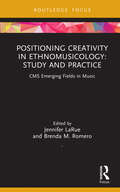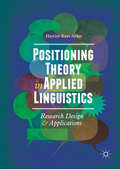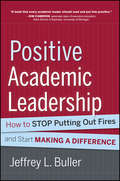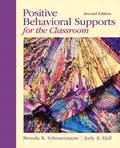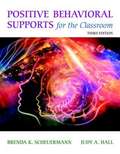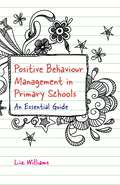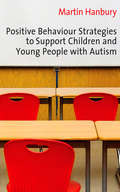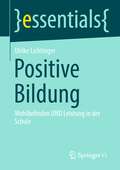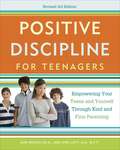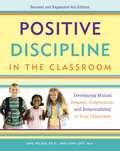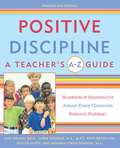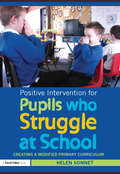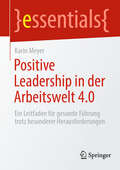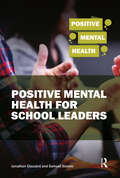- Table View
- List View
Positioning Creativity in Ethnomusicology: Study and Practice (CMS Emerging Fields in Music)
by Brenda M. Romero Jennifer LaRueIn Positioning Creativity in Ethnomusicology: Study and Practice, ethnomusicologists succinctly demonstrate various ways of centering creativity in music higher education. Across six chapters, 12 authors with a variety of specializations and years of experience in (and outside of) academia come together to offer their answers to the question, “What might be possible if we were to (re)position creativity at the center of all we do?” Their contributions range from creative philosophical and theoretical approaches that deemphasize Western canonical views, to practical applications in ensembles, to creative ways of being respectful and reciprocal in complicated cross-cultural relationships in the field (the ethnomusicologist’s research locus), among music faculty, and with students in the classroom.Bringing together a wide range of case studies, the chapters tie anti-colonial advocacy to the creation of spaces where creativity can flourish, show how creative applied ethnomusicology benefits communities, and address the creative pedagogies required to situate diverse musical cultures in the context of academia while overcoming gaps in student and faculty understanding. Providing new insights for scholars, instructors, and students Positioning Creativity in Ethnomusicology is an essential resource that reframes how we practice and teach ethnomusicology.
Positioning Student Affairs for Sustainable Change: Achieving Organizational Effectiveness Through Multiple Perspectives
by James H. Banning Marilyn J. Amey Linda KukAt a time of increasing student diversity, concern about security, demand for greater accountability, and of economic difficulty, what does the future hold for higher education, and how can student affairs organizations adapt to the increasing and changing demands? How can university leaders position existing resources to effectively address these and other emerging challenges with a sense of opportunity rather than dread? How can organizations be redesigned to sustain change while achieving excellence?As student affairs organizations have grown and become increasingly complex in order to meet new demands, they have often emphasized the expansion of their missions to the detriment of focusing on understanding their roles in relationship to other units, to reviewing their cultures and structures, and to considering how they can improve their effectiveness as organizations. This book provides the tools for organizational analysis and sustainability.Intended for practitioners, graduate students, interns and student affairs leaders, this book presents the key ideas and concepts from business-oriented organizational behavior and change theories, and demonstrates how they can be useful in, and be applied to, student affairs practice – and, in particular, how readers can use these theories to sustain change and enhance their organization’s ability to adapt to complex emerging challenges. At the same time it holds to values and perspectives that support the human dimension of organizational life.Recognizing the complexity of today’s organizations and the value of viewing them from multiple perspectives, this book follows the emerging practice of providing three general epistemological perspectives – the Positivist, Social Constructionist, and Postmodernist – for analyzing often paradoxical organizational structures, environments, and behavior.The book explores the environmental context of student affairs, and how the organization interacts with both the internal and external environments; examines the human dimension of organizations, through a review of individual attributes, human need and motivation, social comparison theory and organizational learning theory; presents the dimensions of structure and design theory and discusses why student affairs organizations need to think differently about how they organize their resources; considers the context and process of organizational change, and the dynamics of decision making, power, conflict and communication; addresses the role of assessment and evaluation; and new forms of leadership.Each chapter opens with a case study, and closes with a set of reflective questions.The authors have all served as practitioners within student affairs and now teach and advise graduate students and future leaders in the field.
Positioning Theory in Applied Linguistics: Research Design and Applications
by Hayriye Kayı-AydarThis book is about Positioning Theory (Davies & Harré, 1990) and its potential applications in bilingual and multilingual contexts involving teachers, learners, speakers, and users of a second/foreign or additional language. By using Positioning Theory as a theoretical lens and analytical approach, the author illustrates how various social and poststructural concepts in applied linguistics and language teacher education, including identity, agency, language socialization, classroom participation, and intercultural communication, can be investigated and better understood. The book adds a new perspective to the growing body of multidisciplinary literature in the areas of L2 teacher education and classroom learning, and includes step-by-step guidelines for positioning analysis, insights and implications for classroom practice, as well as suggested directions for future research. It will be of particular interest to language teachers and teacher educators, as well as students and scholars of applied linguistics more broadly.
Positive Academic Leadership: How to Stop Putting Out Fires and Start Making a Difference (Jossey-Bass Resources for Department Chairs #142)
by Jeffrey L. Buller"A book that every academic leader should read and put into practice." —Kim Cameron, associate dean of executive education, Ross School of Business, University of Michigan Praise for Positive Academic Leadership " Buller has produced a book that every academic leader should read and put into practice. Positive Academic Leadership pulls together an amazing array of scientific findings and practical guidelines that will be invaluable for academic leaders looking to improve themselves and their institutions." — Kim Cameron, associate dean, William Russell Professor of Management and Organizations, Ross School of Business; professor of higher education, School of Education, University of Michigan " If I had a magic wand and could make one wish for all of higher education, it would be that we had better institutional leadership. Whether one is a chair, dean, provost, president, or on the Board of Trustees, this book can make a world of difference in your ability to provide that leadership!" — L. Dee Fink, author, Creating Significant Learning Experiences; former president, Professional and Organizational Development Network in Higher Education " Buller's book brings hope for leadership in higher education by emphasizing the importance of a positive approach that empowers and inspires others. Positive Academic Leadership has the potential to transform higher education for the benefit of students, faculty, and ultimately our communities and our world." — Kina S. Mallard, provost and vice president of academic affairs, Carson-Newman University " Academic leaders who find themselves engulfed in negative thinking and considering only damage control scenarios for pressing issues will want to read this book. Employing what Jeffrey Buller calls 'positive academic leadership' is, I believe, essential to transforming feelings of despair into constructive leadership." — Mary Lou Higgerson, vice president for academic affairs, emerita, Baldwin Wallace University " I can't recall reading any book on leadership that is more applicable to the work of faculty development. Every academic leader—faculty member, chair, dean, or campus administrator—will benefit from Jeffrey Buller's evidence-based model and practices of positive academic leadership." — Mary Deane Sorcinelli, associate provost for faculty development, University of Massachusetts Amherst
Positive Alternatives to Exclusion
by Paul Cooper, Mary Jane Drummond, Susan Hart, Jane Lovey and Colleen McLaughlinPositive Alternatives to School Exclusion looks at what schools can do to build more harmonious communities and engage students - particularly those at risk of exclusion - more productively in all areas of school life. It describes the Positive Alternatives to School Exclusion Project, a multi-phase, collaborative initiative based at the School of Education, University of Cambridge.Drawing on the perspectives of staff and pupils, the authors provide detailed case studies of the approaches and strategies being adopted in a variety of settings (primary, secondary and FE) to foster inclusion and reduce and prevent exclusion. It also identifies a number of different frameworks, drawn from the case studies, which can be used by practitioners working in other settings to support their own reflection and development work. Particular importance is placed, throughout the book, on valuing the domain of personal experience in the life of the school community. The authors explore this theme in detail, suggesting ways in which it might become a priority focus of further development work in schools.
Positive Behavior Support at the Secondary "Targeted Group" Level: Yellow Zone Strategies
by Laura A. Riffel Melinda S. MitchinerSeal the gaps in student learning with targeted intervention Research on positive behavior support has focused largely on tier one, school-wide disciplinary policies, and tier three interventions tailored to highly problematic students. This leaves a gap in the middle. "Yellow zone", or tier two, interventions are an extremely effective way to address many challenging behavior and disciplinary issues in small group settings. Positive Behavior Support at the Secondary "Targeted Group" Level shows teachers how to identify the students who can benefit from tier two interventions and demonstrates how to create an implementation plan that delivers results. Focusing on proactive strategies rather than reactive solutions, Riffel and Mitchiner’s research-based techniques include: General strategies that can be applied at the individual student level, such as self-management, proximity control, and the Premack principle and peer mentoring Comprehensive action plans that anticipate the full range of disruptions that may occur A useful behavior rating sheet proven effective in improving student behavior "Funk Sway" For The Classroom: Using Feng Shui principles to create a classroom environment that enhances productivity, learning, and creativity Apply the techniques in this book to reduce challenging behavior, improve school climate, and improve outcomes for ALL students. "This book is easy to read, understand, and implement in any classroom or school. Teachers will be drawn to the resources that can be copied and used immediately! I can’t wait to apply some of these practices in my classroom!" Rachel Spenner, Sixth Grade Teacher Westridge Elementary School
Positive Behavior Support at the Secondary "Targeted Group" Level: Yellow Zone Strategies
by Laura A. Riffel Melinda S. MitchinerSeal the gaps in student learning with targeted intervention Research on positive behavior support has focused largely on tier one, school-wide disciplinary policies, and tier three interventions tailored to highly problematic students. This leaves a gap in the middle. "Yellow zone", or tier two, interventions are an extremely effective way to address many challenging behavior and disciplinary issues in small group settings. Positive Behavior Support at the Secondary "Targeted Group" Level shows teachers how to identify the students who can benefit from tier two interventions and demonstrates how to create an implementation plan that delivers results. Focusing on proactive strategies rather than reactive solutions, Riffel and Mitchiner’s research-based techniques include: General strategies that can be applied at the individual student level, such as self-management, proximity control, and the Premack principle and peer mentoring Comprehensive action plans that anticipate the full range of disruptions that may occur A useful behavior rating sheet proven effective in improving student behavior "Funk Sway" For The Classroom: Using Feng Shui principles to create a classroom environment that enhances productivity, learning, and creativity Apply the techniques in this book to reduce challenging behavior, improve school climate, and improve outcomes for ALL students. "This book is easy to read, understand, and implement in any classroom or school. Teachers will be drawn to the resources that can be copied and used immediately! I can’t wait to apply some of these practices in my classroom!" Rachel Spenner, Sixth Grade Teacher Westridge Elementary School
Positive Behavior Support at the Tertiary Level: Red Zone Strategies
by Laura A. RiffelHelp students move from the “red zone” to the success zone! How would you respond to a student who has tantrums or hits other students? These and other extremely challenging behaviors are identified as tertiary level or “red zone” by the Positive Behavioral Interventions and Supports (PBIS) model. Laura A. Riffel describes in teacher-friendly terms how to use this model to create an intervention plan to modify behavior that disrupts learning. Research-based tools for general and special educators, administrators, and counselors include: A data-driven approach to solving problems Techniques and strategies for collecting and analyzing data Methods for teaching replacement behavior Examples that show how to modify consequences
Positive Behavioral Supports for the Classroom
by Brenda K. Scheuermann Judy A. HallThe field of positive behavioral intervention and support is expanding rapidly, and the revised and reorganized second edition of Positive Behavioral Supports for the Classroom reflects the newest research and most exciting advances. With a new emphasis on the three-tier response-to-intervention model, the text continues to deliver readers an array of research-based strategies and techniques for strengthening appropriate behaviors and reducing challenging ones. Tackling both the "hows" and "whys" of behavioral management in the classroom, this text combines theory and practice in a way that helps students understand and apply effective strategies for behavioral support, assessment, and intervention in both school-wide settings and on an individual basis.
Positive Behavioral Supports for the Classroom
by Brenda K. Scheuermann Judy A. HallIn the new edition of Positive Behavioral Supports for the Classroom, pre- and in-service regular and special education classroom teachers get the latest in research and practice from the field of positive behavior interventions and support, with foundational principles and practices from applied behavior analysis. The book’s emphasis is on a multi-tiered system of support for developing positive behaviors in children and youth, preventing challenging behaviors, and managing challenging behaviors efficiently and effectively school-wide, in classrooms, and for individual students. A wide variety of concepts and techniques are covered, ranging from the most basic through advanced.
Positive Behaviour Management in Early Years Settings: An Essential Guide
by Liz WilliamsDrawing on her extensive practical experience, Liz Williams provides a highly accessible and much-needed guide to promoting positive behaviour in early years settings. In this book, she explains why children may act in the way that they do and how behaviour should be understood differently in children of different ages. She demonstrates that social and emotional capacities differ greatly in these crucial development years and how this impacts on the support needed at each stage. The book considers a host of factors influencing positive behaviour, such as environments and the importance of planning, and looks beyond the child to show the vital role that staff and parents have in promoting appropriate behaviour. Written in clear and understandable language, this book is full of ideas that early years workers can easily implement in their day-to-day work.
Positive Behaviour Management in Primary Schools: An Essential Guide
by Liz WilliamsThis highly accessible and much-needed resource sets out practical advice on positive behaviour management in primary schools, exploring how to support children effectively with their personal, social and emotional development. With an emphasis on implementable strategies, this book will give primary school teachers and staff an understanding as to why children may behave as they do, and what steps can be taken by the school to support a child's development. Considering a variety of factors that influence positive behaviour, such as environment, mental health, parents, and the importance of planning, this book is full of ideas that can be dipped in and out of for support in the classroom. Bite-sized and practical, this is a perfect book for busy teachers.
Positive Behaviour Strategies to Support Children & Young People with Autism
by Dr Martin HanburyTeachers in mainstream schools are increasingly accommodating pupils on the autistic spectrum in their classrooms, and this books offers advice on one of the most difficult aspects of teaching children and young adults with autism - understanding and managing their often challenging behaviour. This book: o explores issues surrounding behaviour support o supplies INSET materials for developing practice in behaviour management o contains self-audit tools for practitioners o gives practical advice on developing an appropriate learning environment o provides guidance on how to promote positive behaviour o contains tried and tested photocopiable material and practical resources. Essential reading for all teachers and teaching assistants working with pupils on the autistic spectrum, this book is based on the sound advice of an experienced practitioner who understands the reality of managing challenging behaviour in the classroom. Martin Hanbury is head of a special school, a regional tutor on the Webautism course at the University of Birmingham and works for the National Autistic Society.
Positive Bildung: Wohlbefinden UND Leistung in der Schule (essentials)
by Ulrike LichtingerIn diesem essential präsentiert Ulrike Lichtinger den Ansatz der Positiven Bildung. Ausgehend von dem Beispiel der australischen Geelong beschreibt sie, was es braucht, um Schulen so auszugestalten, dass sie zu Orten des Gelingens werden, Aufblühen und Potenzialentfaltung von Lehrkräften und Schülerschaft unterstützen und stärken. Dazu stellt sie das Rahmenmodell der Positiven Bildung vor und zeigt anhand einschlägiger Forschung auf, dass Leistung maßgeblich von Wohlbefinden getragen und beeinflusst wird. Das Konzept der Positiven Bildung greift all diese Linien auf, orientiert sich an PERMA, Seligmans fünf Säulen für Wohlbefinden sowie an den Charakterstärken und gibt konkrete Impulse zur Umsetzung in Schule und Unterricht in vier Handlungsfeldern.
Positive Body Image in the Early Years: A Practical Guide
by Ruth MacConvillePromote positive body image, build self-esteem and tackle body confidence issues in young children with this practical guide.Over a quarter of childcare professionals have seen body confidence issues in children aged 3-5 years old. This book explains how body image develops, highlights the warning signs of body dissatisfaction in children and provides guidance for early years practitioners on how to safeguard positive body image by building self-esteem and resilience. It also provides practical guidance and ideas for supporting healthy habits in children and creating bias-free settings.
Positive Discipline Tools for Teachers: Effective Classroom Management for Social, Emotional, and Academic Success
by Jane Nelsen Kelly GfroererMORE THAN 2 MILLION POSITIVE DISCIPLINE BOOKS SOLDThe Positive Discipline method has proved to be an invaluable resource for teachers who want to foster creative problem-solving within their students, giving them the behavioral skills they need to understand and process what they learn. In Positive Discipline Tools for Teachers, you will learn how to successfully incorporate respectful, solution-oriented approaches to ensure a cooperative and productive classroom. Using tools like "Connection Before Correction," "Four Problem-Solving Steps," and "Focusing on Solutions," teachers will be able to focus on student-centered learning, rather than wasting time trying to control their students' behavior. Each tool is specifically tailored for the modern classroom, with examples and positive solutions to each and every roadblock that stands in the way of cooperative learning. Complete with the most up-to-date research on classroom management and the effectiveness of the Positive Discipline method, this comprehensive guide also includes helpful teacher stories and testimonials from around the world. You will learn how to: - Model kind and firm leadership in the classroom- Keep your students involved and intrinsically motivated- Improve students’ self-regulation-And more!
Positive Discipline for Children with Special Needs
by Jane Nelsen Steven FosterOver 2 Million Positive Discipline Books Sold! A Positive Approach To Helping Children With Special Needs Realize Their Potential. Every child deserves to lead a happy and fulfilling life. For parents and teachers of children with special needs, helping their child to not only negotiate daily challenges, but to live fulfilling, meaningful lives, can be the most difficult challenge they will face. Over the years, millions of parents and teachers have come to trust Jane Nelsen's classic Positive Discipline series for its consistent, commonsense approach to childrearing. Now, the bestselling series addresses the specific challenges that parents and teachers of children with special needs face, and offers them straightforward advice for supporting them in positive ways. In these pages are practical solutions to challenges such as: Learning to look beyond diagnostic labels; Believing in each child's potential regardless of his/her stage of development; Helping children integrate socially and interact with their peers; Coping with the frustration that inevitably occurs when a child is being difficult; Strengthening a child's sense of belonging and significance; And Many More! Use this book to answer such questions as: * How do you accommodate a disability, while still teaching a child to try their best? * How do you help a child cope with anger they may have trouble expressing, especially when that anger may on some level be justified? * How do you teach a child who may struggle with seemingly straight forward tasks to contribute to the world around them in a way that will be meaningful to them? "If you are raising or teaching a child with special needs, this book is a must-read. As the mother of a child with autism, my hopes and dreams for my son were no different than those of other parents. I wanted a parenting approach that helped my child grow up to be self confident, happy, and prepared for success in relationships, work, and life. I also needed practical, effective methods for addressing the significant, challenging behaviors I faced on a daily basis. Finally, in this amazing book, I found both....Thank you, thank you, thank you to the authors of this groundbreaking book." - Rachel Fink Parks, MS, PCC.
Positive Discipline for Teenagers, Revised 3rd Edition: Empowering Your Teens and Yourself Through Kind and Firm Parenting
by Jane Nelsen Lynn LottA Positive Approach To Raising Happy, Healthy and Mature Teenagers Adolescence can be a time of great stress and turmoil--not only for kids going through it, but for their parents as well. It's normal for teens to explore a new sense of freedom and to redefine the ways in which they relate to their parents, and that process can sometimes leave parents feeling powerless, alienated, or excluded from their children's lives. These effects can be magnified even further in this modern age of social networks, cell phones, and constant digital distraction. This newly revised and updated edition of Positive Discipline for Teenagers shows parents how to build stronger bridges of communication with their children, break the destructive cycles of guilt and blame that occur in parent-teen power struggles, and work toward greater mutual respect with their adolescents. At the core of the Positive Discipline approach is the understanding that teens still need their parents, just in different ways--and by better understanding who their teens really are, parents can learn to encourage both their teens and themselves, and instill good judgment without being judgmental. The methods in this book work to build vital social and life skills through encouragement and empowerment--not punishment. Truly effective parenting is about connection before correction.Over the years, millions of parents have come to trust Jane Nelsen's classic Positive Discipline series for its consistent, commonsense approach to raising happy, responsible kids. This new edition is filled with proven, effective methods for coping with such parenting challenges as: -Fostering truly honest discussions with your teen-Helping your teen handle the online world -Turning mistakes into opportunities-Keeping your sanity while raising your teen--and making sure your own teenage issues aren't weighing you down-Teaching your teen how to pursue the goal that make them happy...and a few that make you happy too (like chores)-Making sure you're on your teen's side, and that they know that-Avoiding the pitfalls of excessive control and excessive permissiveness
Positive Discipline in the Classroom: Developing Mutual Respect, Cooperation, and Responsibility in Your Classroom (Positive Discipline)
by Jane Nelsen Lynn Lott H. Stephen GlennThe Acclaimed Bestseller That Can Improve Your Classroom Experience Forever!Over the years, millions of parents have come to trust the classic Positive Discipline series for its consistent, commmonsense approach to child rearing. Hundreds of schools also use these amazingly effective strategies for restoring order and civility to today's turbulent classrooms. Now you too can use this philosophy as a foundation for fostering cooperation, problem-solving skills, and mutual respect in children. Imagine, instead of controlling behavior, you can be teaching; instead of confronting apathy, you will enjoy motivated, eager students! Inside, you'll discover how to: ·Create a classroom climate that enhances academic learning ·Use encouragement rather than praise and rewards ·Instill valuable social skills and positive behavior through the use of class meetings ·Understand the motivation behind students' behavior instead of looking for causes ·And much more! Over 1 million Positive Discipline books sold!From the Trade Paperback edition.
Positive Discipline: Hundreds of Solutions for Almost Every Classroom Behavior Problem!
by Jane Nelsen Linda Escobar Kate Ortolano Roslyn Duffy Deborah Owen-SohockiTake Back the Classroom and Make a Positive Difference in Your Students' Lives Many teachers today are facing problems and discipline issues they never dreamed of when they decided to become teachers. Combine violence, behavioral disorders, and downright defiant attitudes from students with the age-old problems of bullying, poor attendance, and more, and the mix is positively lethal. However, there are effective, positive strategies for restoring order and turning the teacher-student relationship into one of mutual respect. Applicable to all grade levels, this comprehensive A to Z guide addresses modern-day problems and practical solutions for establishing an effective learning environment. Inside, you'll discover: ·The 17 fundamental tools of positive discipline ·Real-life stories of proven positive discipline strategies ·Suggestions for establishing and maintaining respectful, nurturing relationships with students ·And much more! "Overcome obstacles and get back to why you became a teacher in the first place: to empower students with confidence, self-respect, and resourcefulness. " --Bill Scott,principal, Birney Elementary School, Murietta, Georgia "An inspiring, information-packed book. All teachers--from those just beginning to those with many years of experience--will find the tools of positive discipline easy to use. " --Phillip Harris, Ed. D. ,director, Center for Professional Development and Services, Phi Delta Kappa International
Positive Interaction Skills: A Group Therapy Manual
by Robin DynesThis practical, photocopiable manual provides group leaders with a flexible programme to teach interaction skills that can be adapted to a wide variety of groups, situations and needs. The programme will benefit anyone who lacks adequate skills or who has difficulty interacting with other people at home, socially or at work, for example adults with very few or no formal qualifications, people with depression or schizophrenia, young people in schools or people with learning disabilities. The book is filled with workable ideas and the sessions are designed to be used independently as required to meet identified needs. Full guidance notes for facilitators, session plans, handouts and activity guidelines are provided and this will be an invaluable resource for anyone wanting to run an interaction skills programme.
Positive Interactions with At-Risk Children: Enhancing Students’ Wellbeing, Resilience, and Success
by Mojdeh Bayat Naseem JamniaFind the tools and knowledge you need to build resilience in all children from an early age through appropriate interactions and conversations. Presenting a wide range of research in an accessible format, Positive Interactions with At-Risk Children explains how to understand and assess behaviors in the context of children’s developmental stages. This book introduces Bayat's original Resilience-based Interaction Model (RIM), which combines behavioral and emotion-based theories of development to provide practical steps for early childhood teachers and professionals. RIM features research-based practices, including relationship building, behavior guidance, body-mind exercises for both teachers and students, as well as strategies to promote strengths of character in children and aid future learning. Ideal for new and veteran educators alike, Positive Interactions with At-Risk Children is an invaluable guide to early years behavior.
Positive Intervention for Pupils who Struggle at School: Creating a Modified Primary Curriculum
by Helen SonnetPositive Intervention for Pupils who Struggle at School provides the resources and information primary teachers need to ensure a happy and effective school experience for all children, particularly those who are seriously struggling. This tried and tested intervention is designed specifically for those children who have been through all the standard interventions, to no avail, and who are now in danger of being excluded.Explaining the thinking behind the suggested modified curriculum, this innovative book considers the reasons why certain children experience difficulties and looks at how this curriculum addresses their needs and enables them to develop personal, social and emotional skills. The activities are chosen to develop and enhance skills for learning, including listening, speaking, concentrating, a positive disposition and a willingness to take on new challenges. Helen Sonnet demonstrates how success has been achieved through this strategy and provides valuable information to help teachers to set up similar groups in their own schools, including how to: ensure firm foundations for the group select the children who will benefit most establish the structures and routine of a successful group assess the children’s progress reintegrate children into their mainstream classes effectively. In line with government initiatives this important and effective intervention strategy can make the world of difference, giving teachers new, proven strategies to enable them to support children who are struggling in mainstream primary schools.
Positive Leadership in der Arbeitswelt 4.0: Ein Leitfaden für gesunde Führung trotz besonderer Herausforderungen (essentials)
by Karin Meyer„Immer mehr, schneller und mit möglichst geringen Ressourcen“ lautet oftmals die Devise in der Arbeitswelt 4.0. Dabei ist es möglich, Unternehmens- und Mitarbeiterinteressen bestmöglich zu vereinen – also, Unternehmen (noch) erfolgreicher zu machen und gleichzeitig Wohlbefinden und Gesundheit der Mitarbeitenden zu stärken. Denn ökonomisches und soziales Wohlergehen können sich sinnvoll komplementär ergänzen. Beleuchtet werden daher wesentliche Grundlagen für Wohlbefinden, Gesundheit und unternehmerischen Erfolg – ebenso wie die Umsetzung in die Praxis mittels Positive Leadership gelingen kann.
Positive Mental Health for School Leaders (Positive Mental Health)
by Jonathan Glazzard Samuel StonesThe mental health of school leaders and managers is just as important as the well-being of those they teach and support. Recent research reveals some alarming statistics, including that 56% of senior leaders have experienced mental ill health in the last year. This book examines a range of relevant issues including workload, inspections, partnerships and approaches to leadership and management in order to address some of these concerns and provide comprehensive guidance and workable, evidence-informed strategies to support those with leadership roles in schools and colleges.
